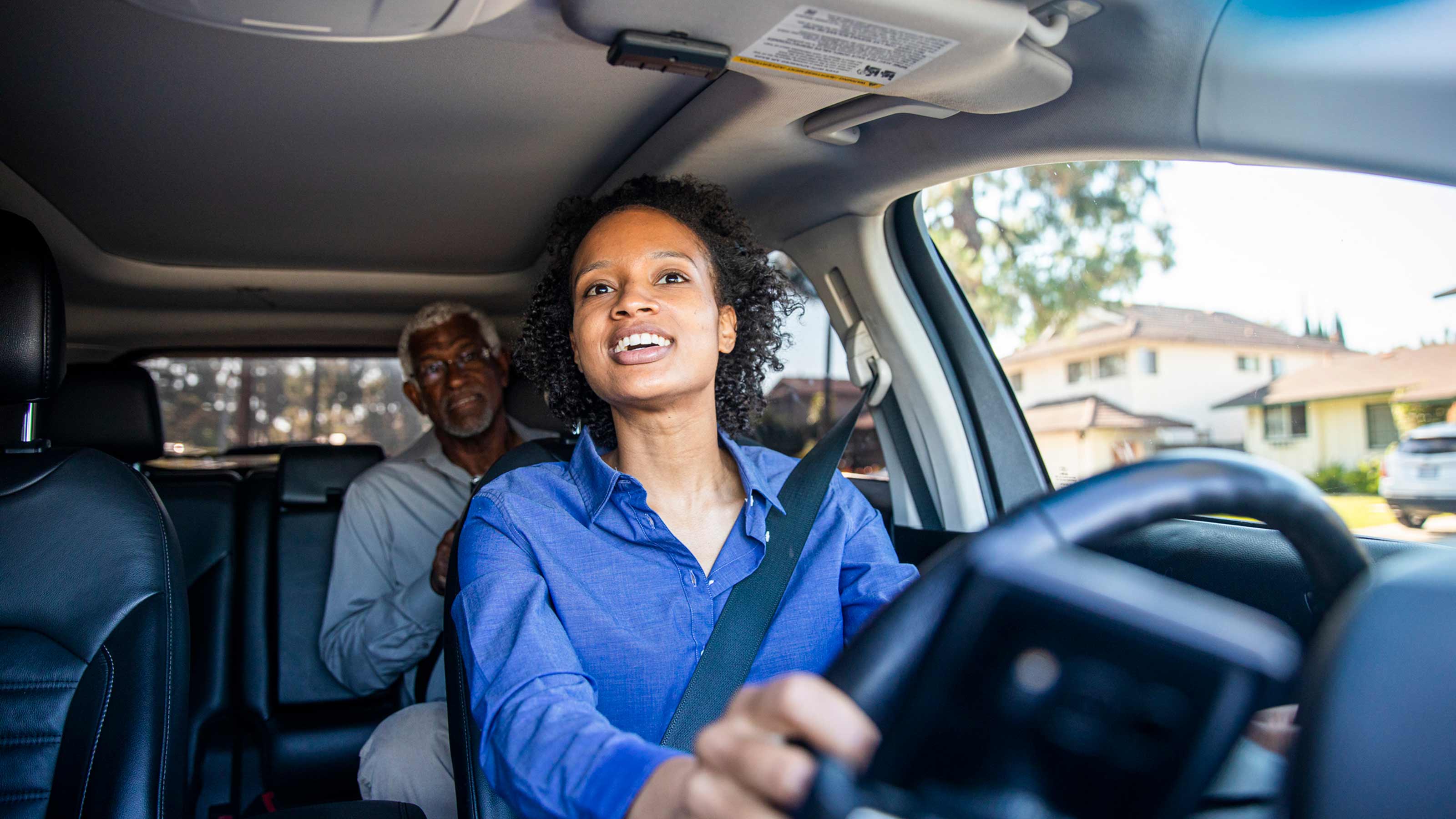Going Places Without a Car in Retirement
For many older adults, having an alternative mode of transportation may be the difference between independence and social isolation.

Maria Seltzer used to drive downtown from the eastern part of San Diego County to the theater. Then she began driving instead to a nearby Metropolitan Transit System trolley stop, where she could park her car for free and ride about an hour into the city. “I like musicals,” Seltzer says. “If it’s a musical, I’m in.”
Though Seltzer, 79, still drives, getting to the theater and ballet was becoming more difficult, especially competing for a parking spot downtown. “I was glad I could find a different way to get there,” she says.
In the midst of a deadly pandemic, it may be hard to imagine a time when riding mass transit or getting into a city cab will be perfectly normal things to do for anyone, let alone senior citizens. But eventually, when it becomes safe to do so, life will resume, and for many older adults, who no longer feel comfortable driving, having an alternative mode of transportation may be the difference between independence and social isolation.
From just $107.88 $24.99 for Kiplinger Personal Finance
Become a smarter, better informed investor. Subscribe from just $107.88 $24.99, plus get up to 4 Special Issues

Sign up for Kiplinger’s Free Newsletters
Profit and prosper with the best of expert advice on investing, taxes, retirement, personal finance and more - straight to your e-mail.
Profit and prosper with the best of expert advice - straight to your e-mail.
According to the American Journal of Public Health, Americans on average outlive their ability to drive safely by 10 years for women and seven years for men. Like Seltzer, three-quarters of Americans age 65 and older live in suburban and rural areas where mass transit options can be minimal, if they exist at all.
Even some cities fall short. San Diego isn’t like New York City where you just get on the subway, says Seltzer, a former dancer who lived in New York before she and her late husband moved to California. “We don’t have that here.”
Becoming a Passenger
Most Americans equate driving with autonomy and prefer not to think about a time when they can no longer drive, leaving them unprepared once that day finally arrives.
“They think they’re going to drive forever,” says Katherine Freund, founder of the Independent Transportation Network of America, a nonprofit transportation network for seniors and the visually impaired. Through affiliates or partnerships, ITN provides transportation for seniors in communities in 47 states.
Eventually, though, something happens that prevents you from getting behind the wheel. Your vision deteriorates, for example, or you have a knee or hip replacement. Typically, “it’s not an all-or-nothing situation,” Freund says, adding that the transition from driver to passenger usually happens in stages over 10 years.
At first, you might stop driving at night or to unfamiliar places. Then it might be avoiding longer distances or nearby cities. Research from the AAA Foundation for Traffic Safety found that 1 in 5 older drivers reduced their driving in the past year, with 57% of women and 43% of men reporting they had cut back. Over time, those cutbacks add up, potentially limiting your social interaction and damaging your quality of life.
“Social isolation and loneliness are real concerns for our growing population of older people,” says Lisa D’Ambrosio, a research scientist with the Massachusetts Institute of Technology AgeLab in Cambridge.
Social media and virtual connections like FaceTime are helpful but not always enough, as many Americans discovered when the coronavirus kept them isolated in their homes. Some people want, need and can benefit from more personal interactions, not just the virtual ones, D’Ambrosio says.
Location Is Everything
Beyond the social benefits, reliable public transportation is essential for daily life, and location is everything when it comes to finding practical alternatives to driving. Some communities have better public transportation than others, including paratransit for disabled passengers who can’t use a public bus that follows a fixed route.
“Where you choose to live becomes very important,” says Shawn Brennan, transportation and mobility manager for Maryland’s Montgomery County Aging and Disability Services.
Experts suggest researching transportation options when you’re considering where to live in retirement. “Think about these things before they become an issue,” says Rhonda Shah, a project manager with AAA Traffic Safety Advocacy. “Transportation definitely should be one consideration before you make a move.”
For example, think of five places you regularly want or need to go: supermarkets, the post office, a doctor’s office, your children’s home or a place of worship.
“How do you get there now, and how might you get there without a car?” asks licensed certified social worker Beth Shapiro, who developed a course, To Drive or Not to Drive, that helps people transition from driver to passenger.
Consider your support system in the town or city where you plan to retire. Family members and friends can help but only to a point. They may be busy with their own lives, which means finding alternatives and learning how to use them.
“Public transportation can be intimidating so build up your comfort level by practicing with a friend or family member,” says AAA’s Shah.
If you’re in good health, look for pedestrian-friendly neighborhoods with places you can walk to. Some retirees also are turning to pedal-assist electric bicycles and three-wheelers for making short, local trips.
Nonprofits to the Rescue
Keep in mind that some transit options may be through nonprofit or private organizations. For example, in Sussex County, Del., where many retired people live and public transportation is minimal, nonprofit group and ITN affiliate Independent Transportation Network Southern Delaware fills the void. The organization has 300 members age 55 and older who rely on volunteer drivers.
“Most of these people do not drive at all,” says retired teacher and administrator Joe Feichtl, who has been a volunteer driver with the group for four years. “They are stuck in the house. We drive 24 hours a day.”
Area residents regularly schedule rides to doctor’s appointments, religious services, grocery stores, drug stores, concerts, theaters, restaurants and hair salons. Members deposit an initial $50 into their accounts to cover the transit cost of $1.50 per mile plus a $3.50 pickup fee. No money changes hands, and no tipping is allowed. The membership fee is $40 per year for individuals, $70 for families.
Some of the group’s members who still drive prefer not to if it’s a longer trip late at night. For example, one woman in her mid-50s reserved a volunteer driver to take her to her daughter’s birthday party at 10 p.m. in Ocean City, Md., 22 miles from her home in Delaware.
Transit Resources
When scouting out transportation options, here are some organizations that can help:
- If you still drive, AAA offers a driver refresher course in most states ($15.95, members; $19.95, nonmembers). An online course through AARP ranges between $20 and $30, depending on the state, with discounts available for members.
- GoGo enables people without smartphones to use ride service companies Uber and Lyft by calling 855-464-6872. The “concierge” fee is 27 cents per minute added to the Uber or Lyft fare; operators will quote an approximate fare before sending a vehicle. You can set up an account by phone or online, and the service will charge the card you have on file. There is no membership fee. Ask the operator if service is available in your area.
- National Volunteer Transportation Center can help you find nonprofit transportation alternatives in your community.
- Rides in Sight has a database that you can search by location for transportation options that serve seniors and the visually impaired.
- Village to Village Network helps communities establish a “village,” a group of volunteers that typically provides rides and other assistance for older adults. Visit the site to find or start a village.
- Walkscore rates cities, towns and neighborhoods based on how easily stores, parks and other destinations can be reached on foot.
Profit and prosper with the best of Kiplinger's advice on investing, taxes, retirement, personal finance and much more. Delivered daily. Enter your email in the box and click Sign Me Up.
Harriet Edleson is an expert on baby boomer retirement strategies. She has written the Retiring feature for The New York Times and the Where We Live feature for The Washington Post. A former writer/editor/producer for AARP where she specialized in Social Security, she now writes for Kiplinger's Retirement Report. A graduate of Mount Holyoke College with a B.A. in sociology, she began her writing career at the Gannett Westchester (N.Y.) Newspapers and the Houston Chronicle. Her forthcoming book, 12 Ways to Retire on Less: Planning an Affordable Future, is to be published by Rowman & Littlefield in May 2021. Other areas of interest are real estate, health, and travel.
-
 Dow Adds 646 Points, Hits New Highs: Stock Market Today
Dow Adds 646 Points, Hits New Highs: Stock Market TodayIt was "boom" for the Dow but "bust" for the Nasdaq following a December Fed meeting that was less hawkish than expected.
-
 5 Types of Gifts the IRS Won’t Tax: Even If They’re Big
5 Types of Gifts the IRS Won’t Tax: Even If They’re BigGift Tax Several categories of gifts don’t count toward annual gift tax limits. Here's what you need to know.
-
 The 'Scrooge' Strategy: How to Turn Your Old Junk Into a Tax Deduction
The 'Scrooge' Strategy: How to Turn Your Old Junk Into a Tax DeductionTax Deductions We break down the IRS rules for non-cash charitable contributions. Plus, here's a handy checklist before you donate to charity this year.
-
 Amazon Resale: Where Amazon Prime Returns Become Your Online Bargains
Amazon Resale: Where Amazon Prime Returns Become Your Online BargainsFeature Amazon Resale products may have some imperfections, but that often leads to wildly discounted prices.
-
 What Does Medicare Not Cover? Eight Things You Should Know
What Does Medicare Not Cover? Eight Things You Should KnowMedicare Part A and Part B leave gaps in your healthcare coverage. But Medicare Advantage has problems, too.
-
 457 Plan Contribution Limits for 2026
457 Plan Contribution Limits for 2026Retirement plans There are higher 457 plan contribution limits in 2026. That's good news for state and local government employees.
-
 Medicare Basics: 12 Things You Need to Know
Medicare Basics: 12 Things You Need to KnowMedicare There's Medicare Part A, Part B, Part D, Medigap plans, Medicare Advantage plans and so on. We sort out the confusion about signing up for Medicare — and much more.
-
 The Seven Worst Assets to Leave Your Kids or Grandkids
The Seven Worst Assets to Leave Your Kids or Grandkidsinheritance Leaving these assets to your loved ones may be more trouble than it’s worth. Here's how to avoid adding to their grief after you're gone.
-
 SEP IRA Contribution Limits for 2026
SEP IRA Contribution Limits for 2026SEP IRA A good option for small business owners, SEP IRAs allow individual annual contributions of as much as $70,000 in 2025, and up to $72,000 in 2026.
-
 Roth IRA Contribution Limits for 2026
Roth IRA Contribution Limits for 2026Roth IRAs Roth IRAs allow you to save for retirement with after-tax dollars while you're working, and then withdraw those contributions and earnings tax-free when you retire. Here's a look at 2026 limits and income-based phaseouts.
-
 SIMPLE IRA Contribution Limits for 2026
SIMPLE IRA Contribution Limits for 2026simple IRA For 2026, the SIMPLE IRA contribution limit rises to $17,000, with a $4,000 catch-up for those 50 and over, totaling $21,000.